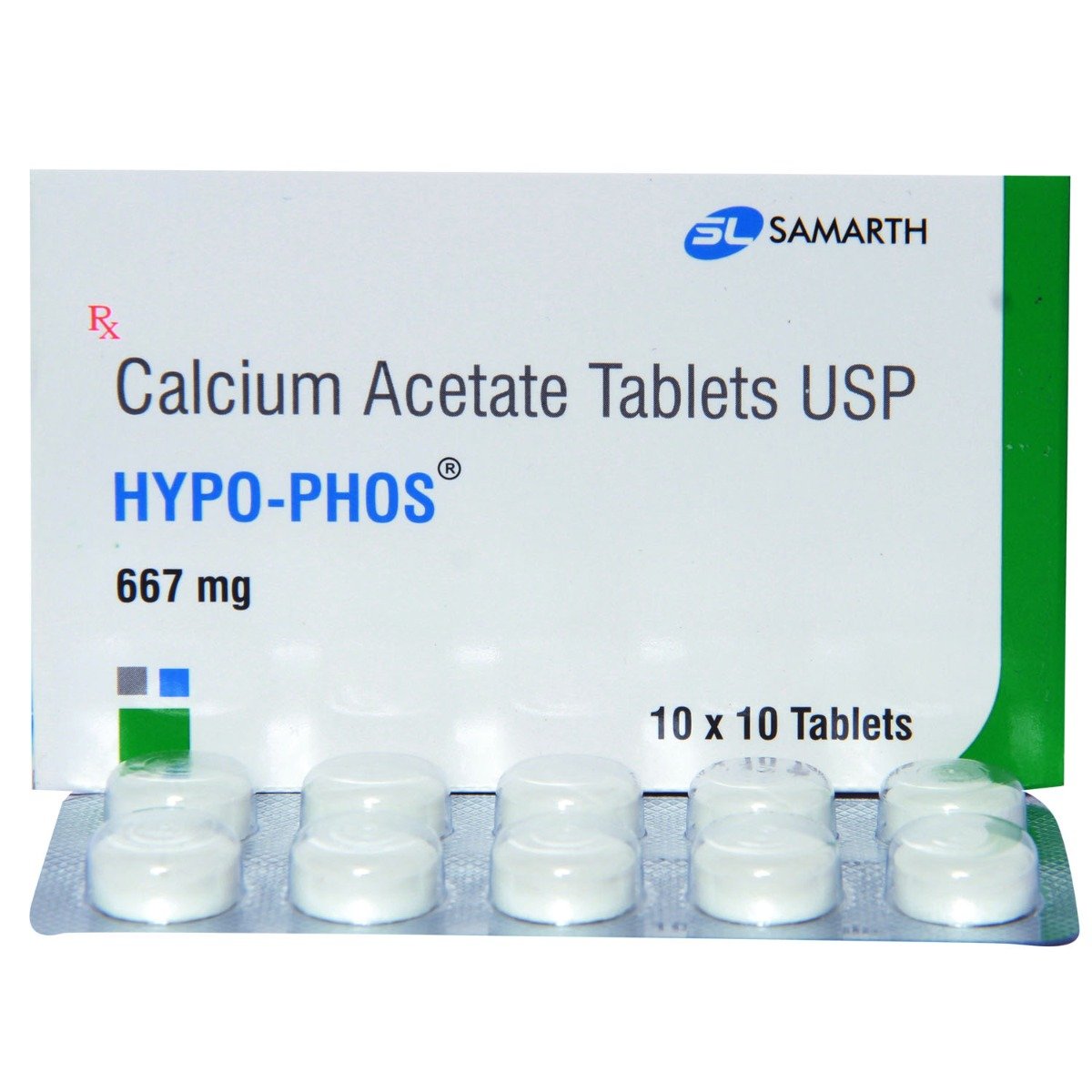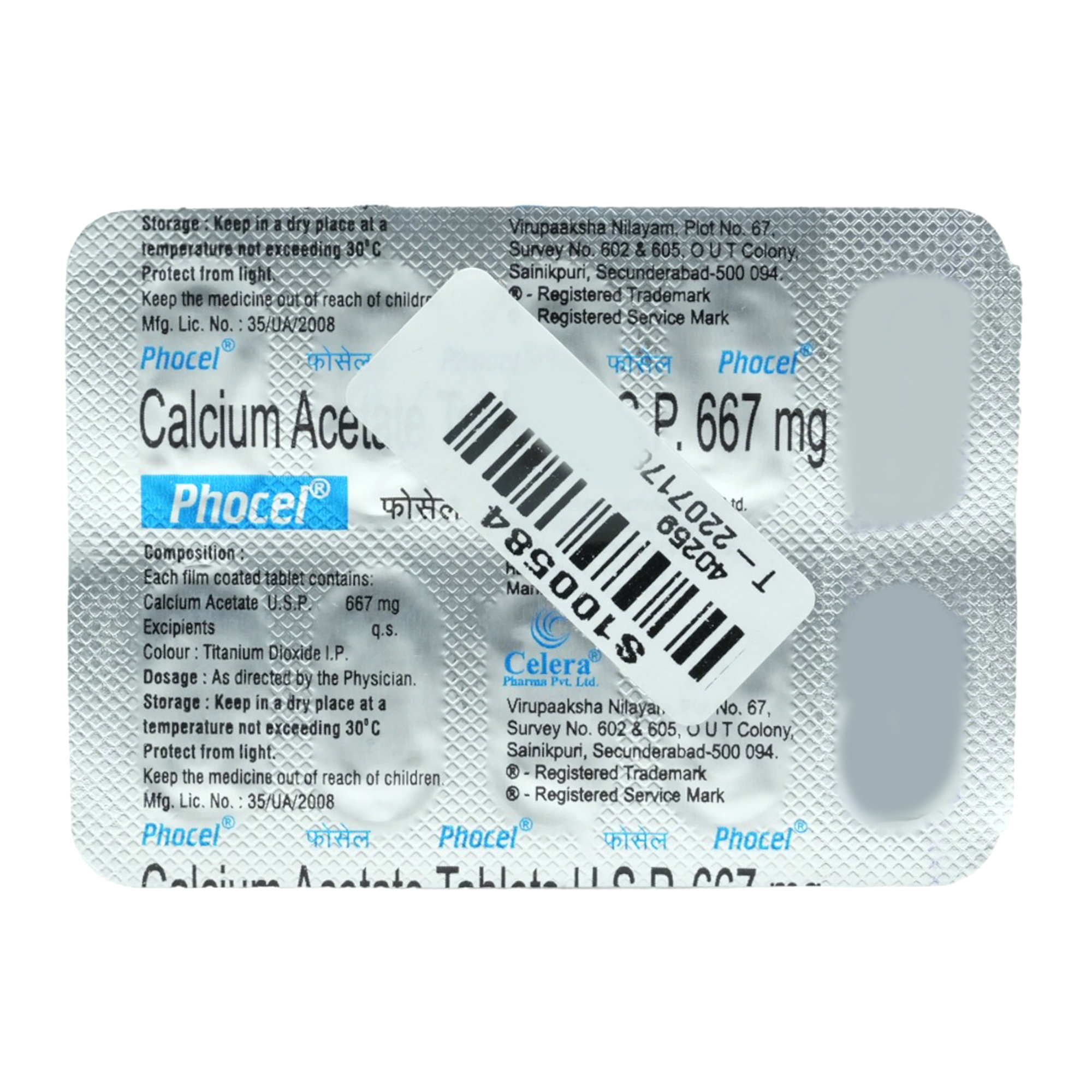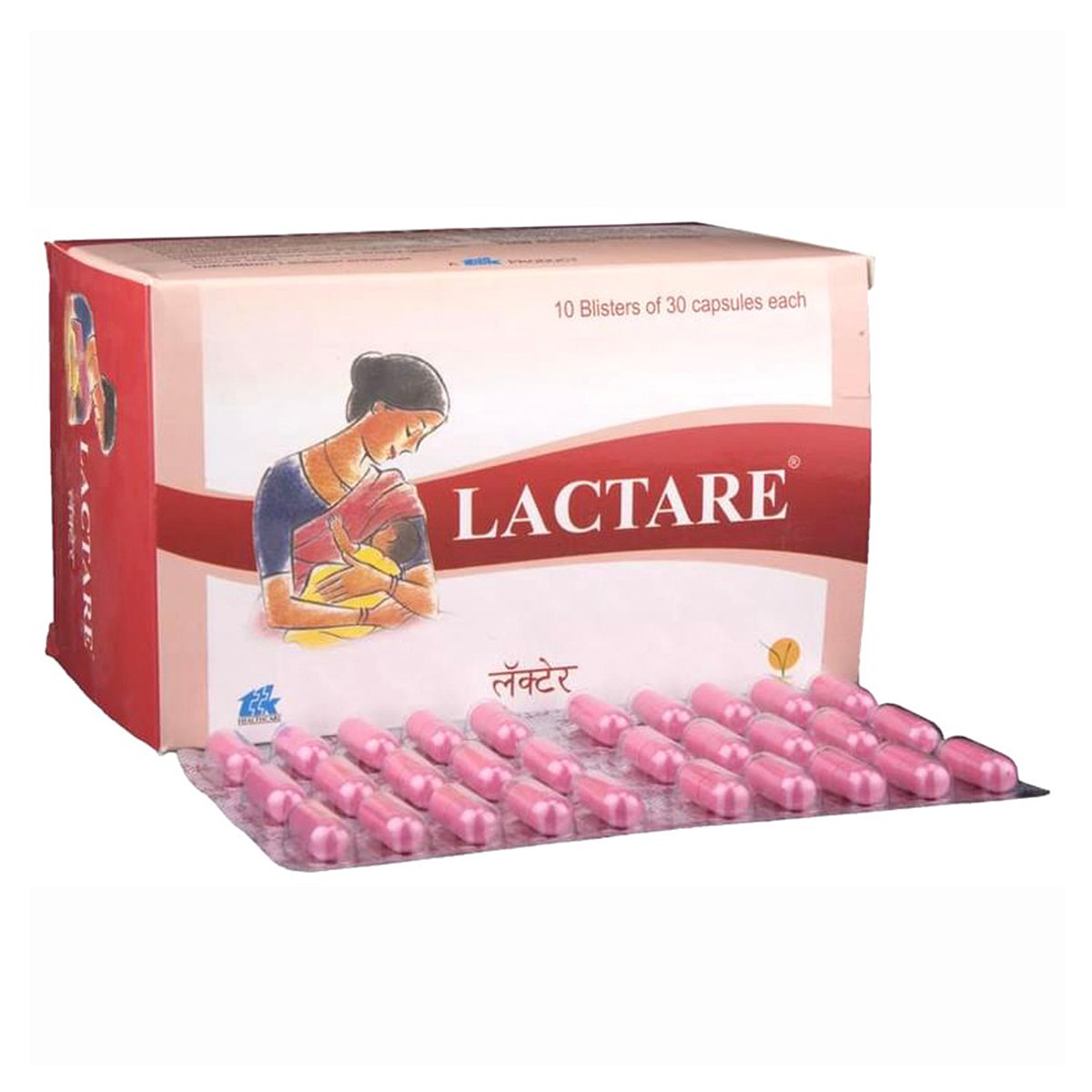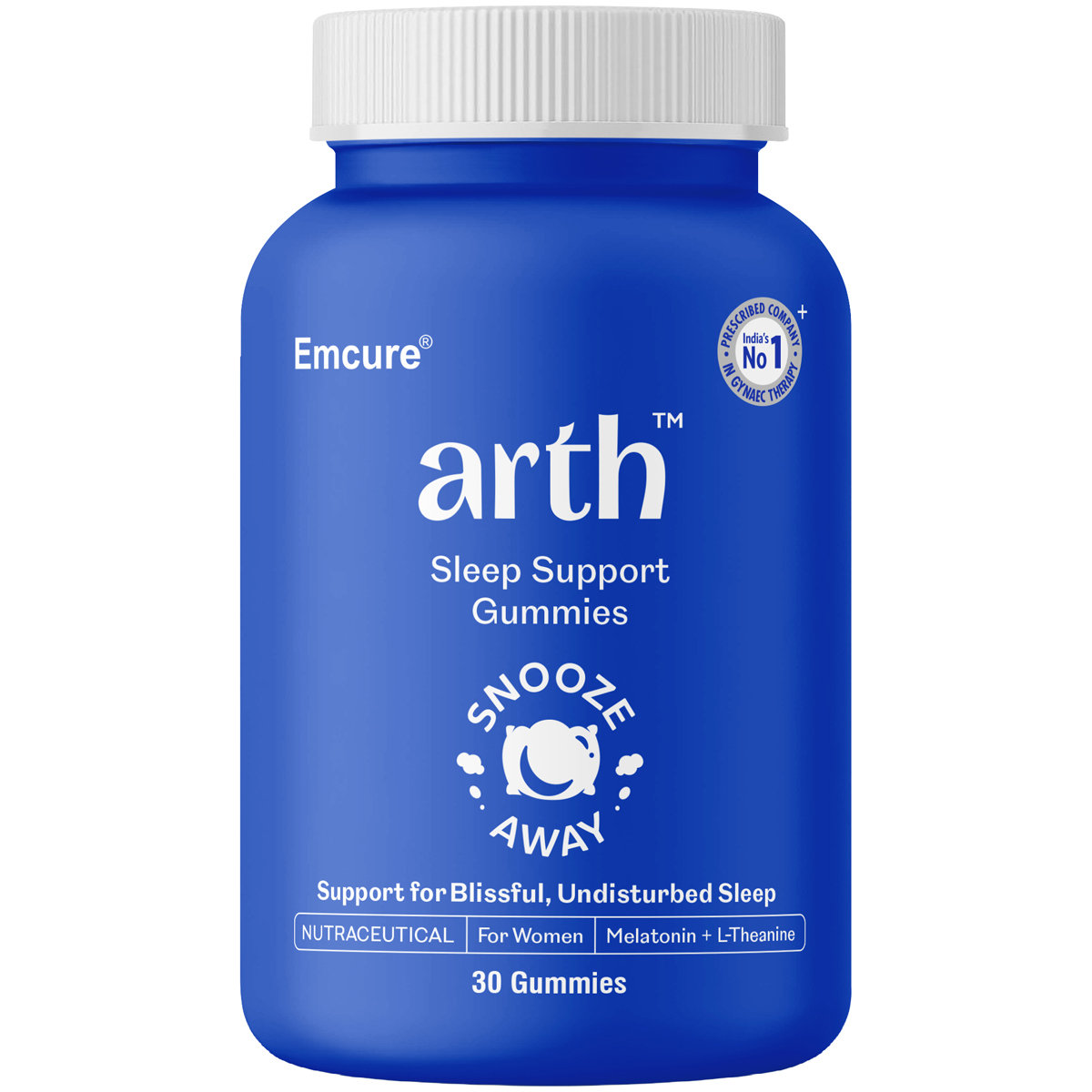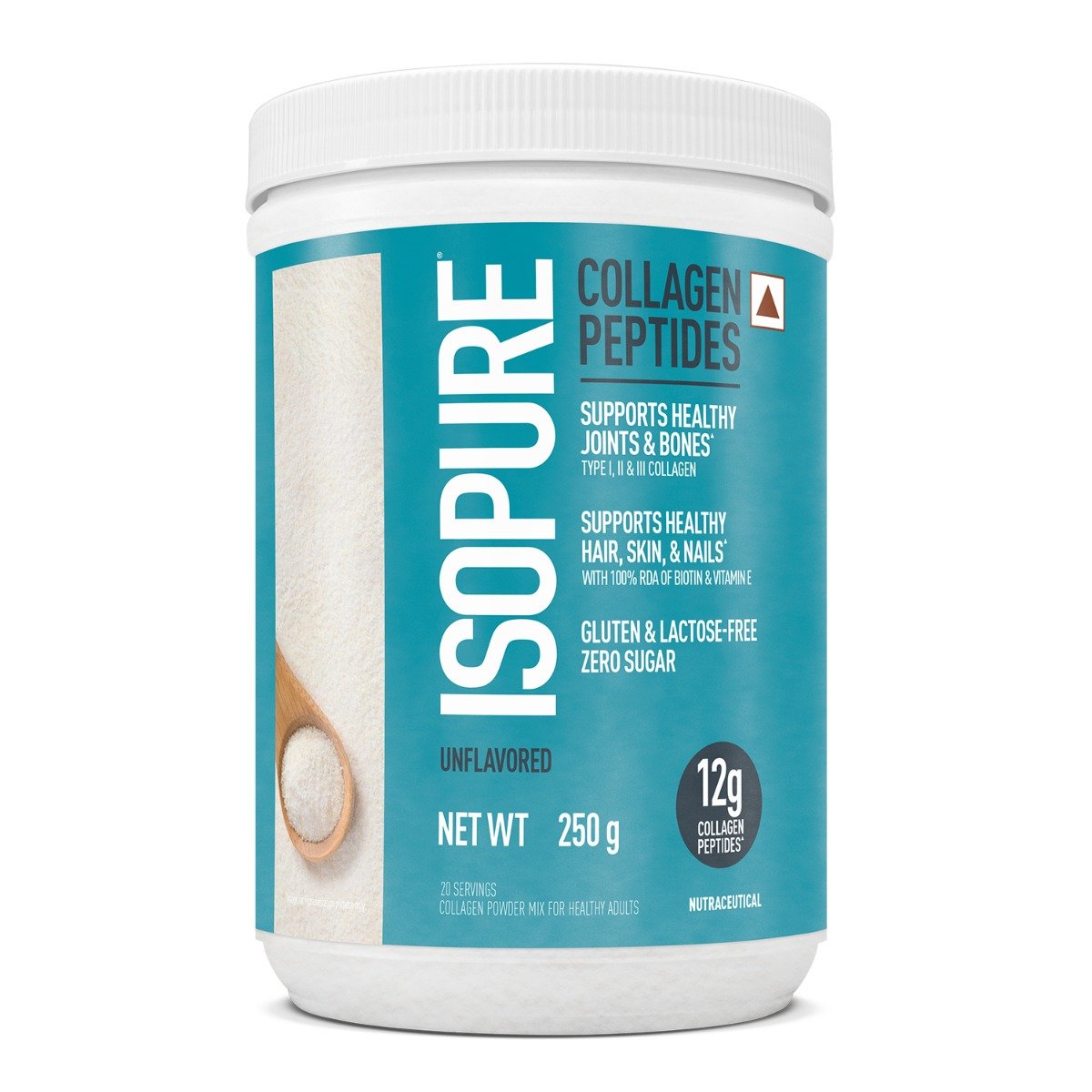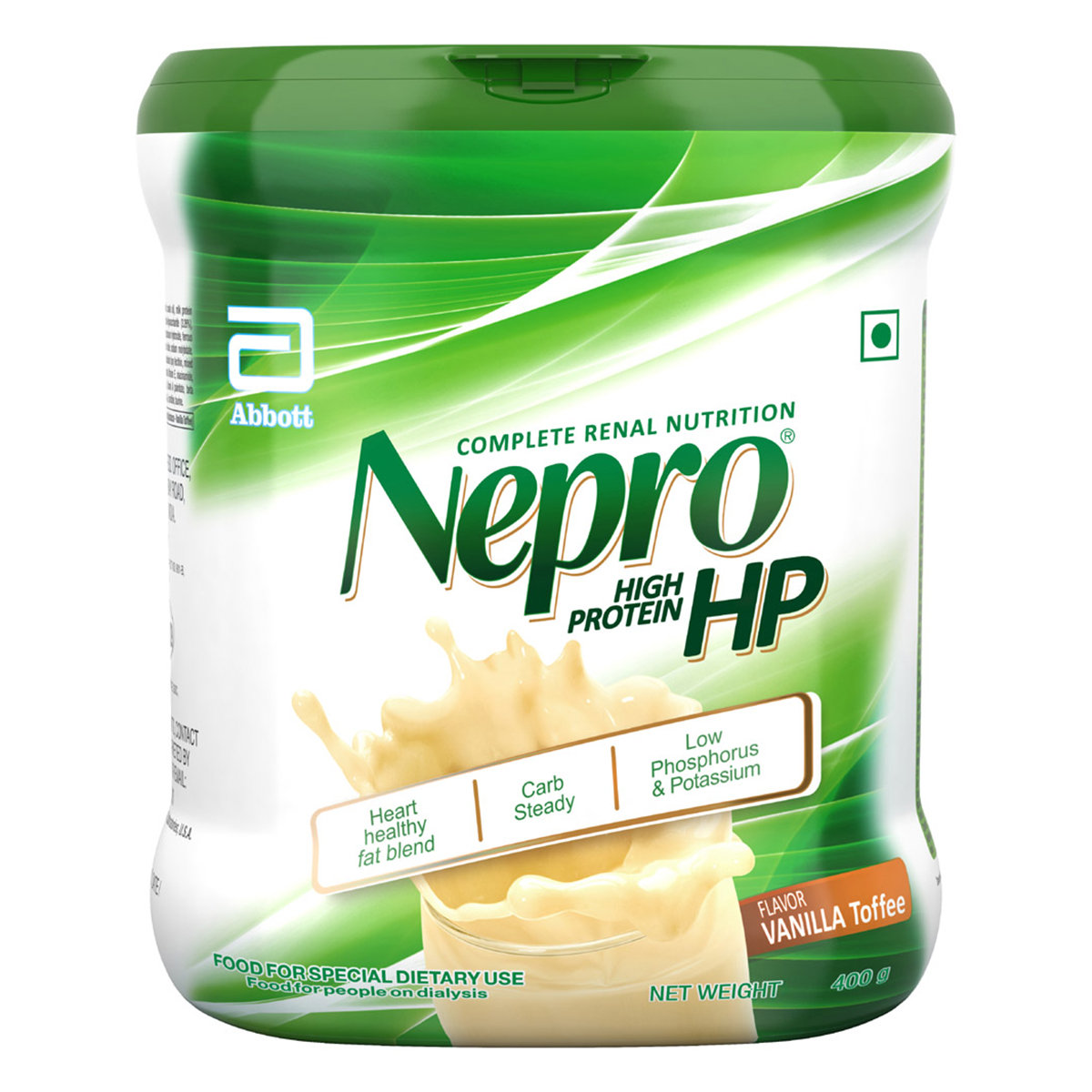Phostat Tablet 10's
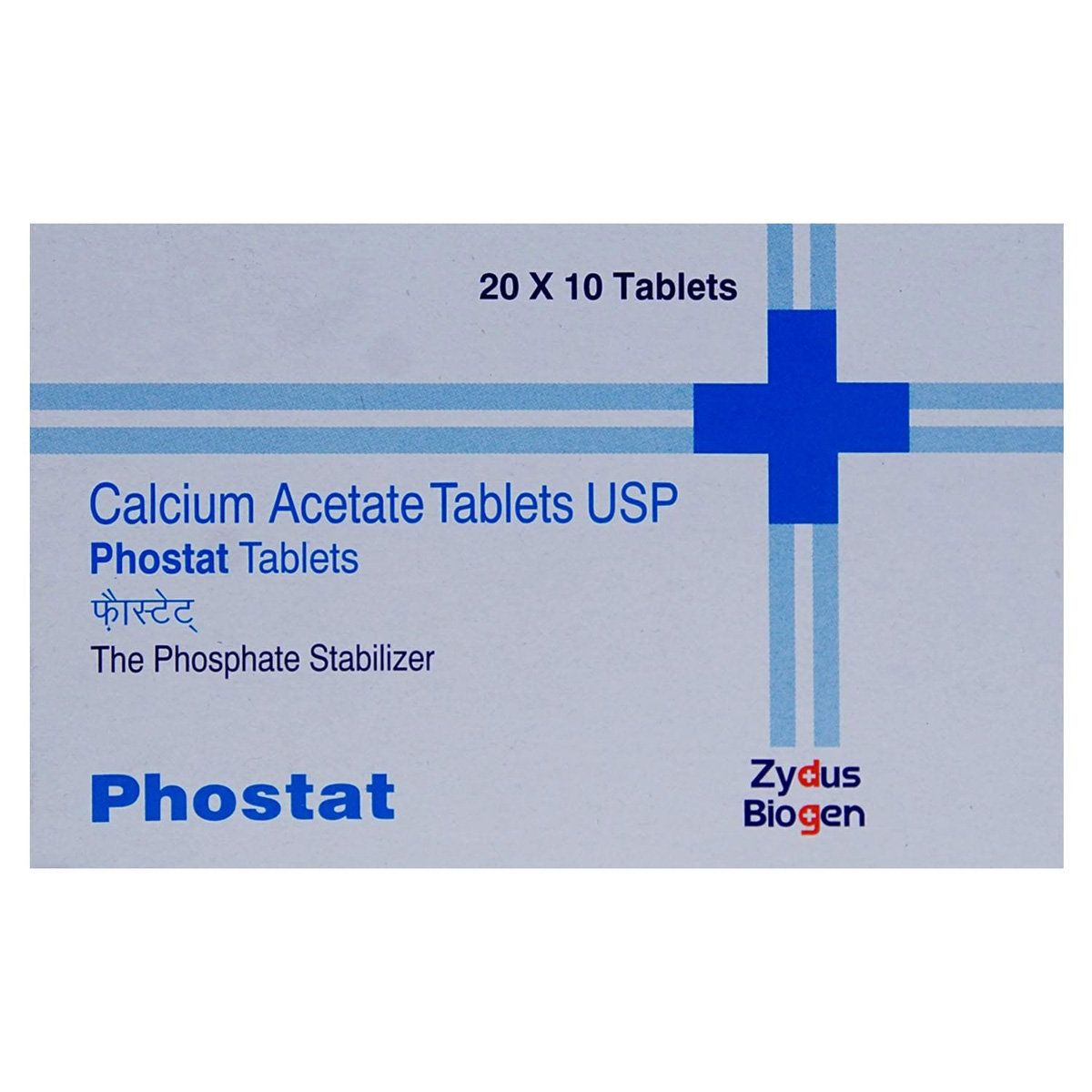
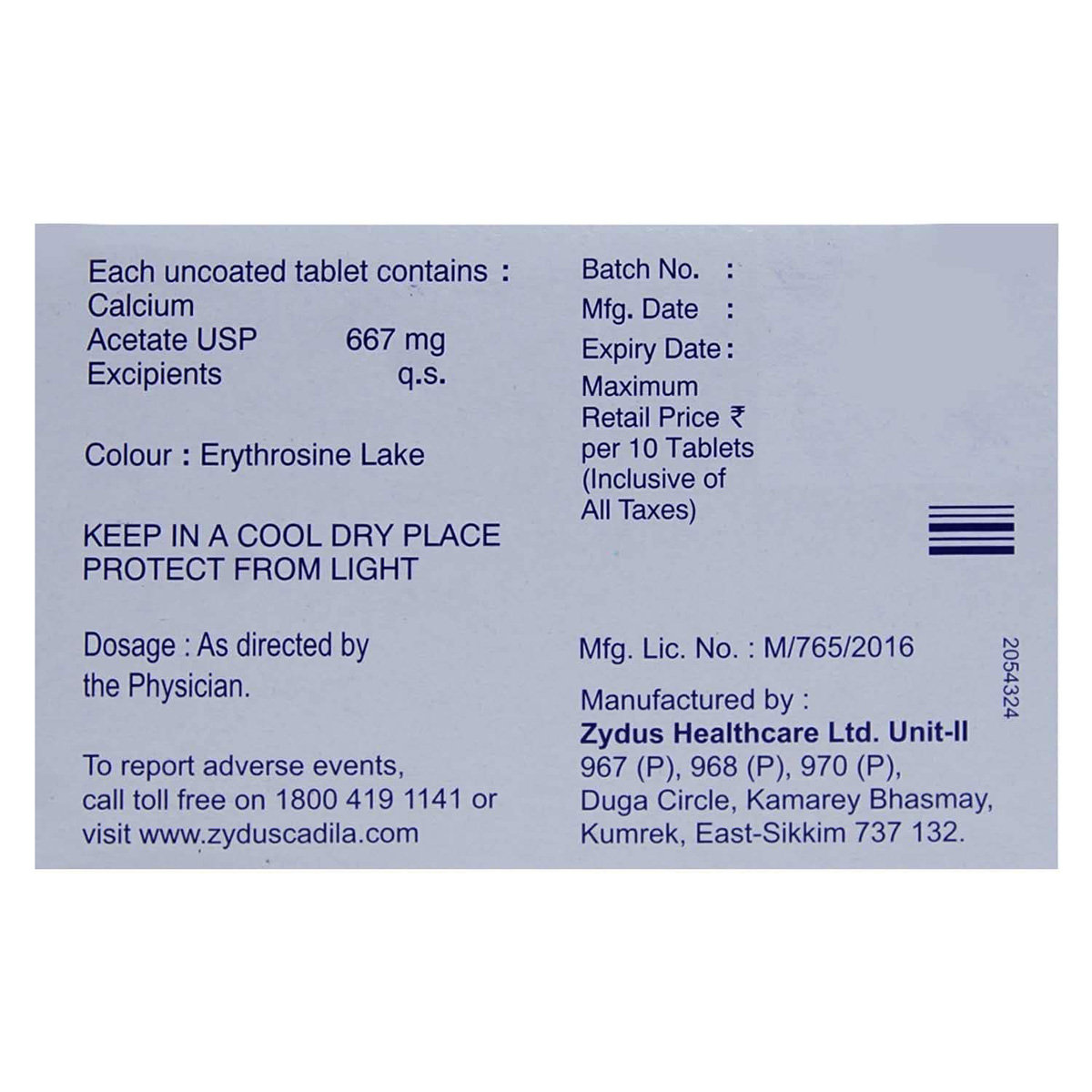
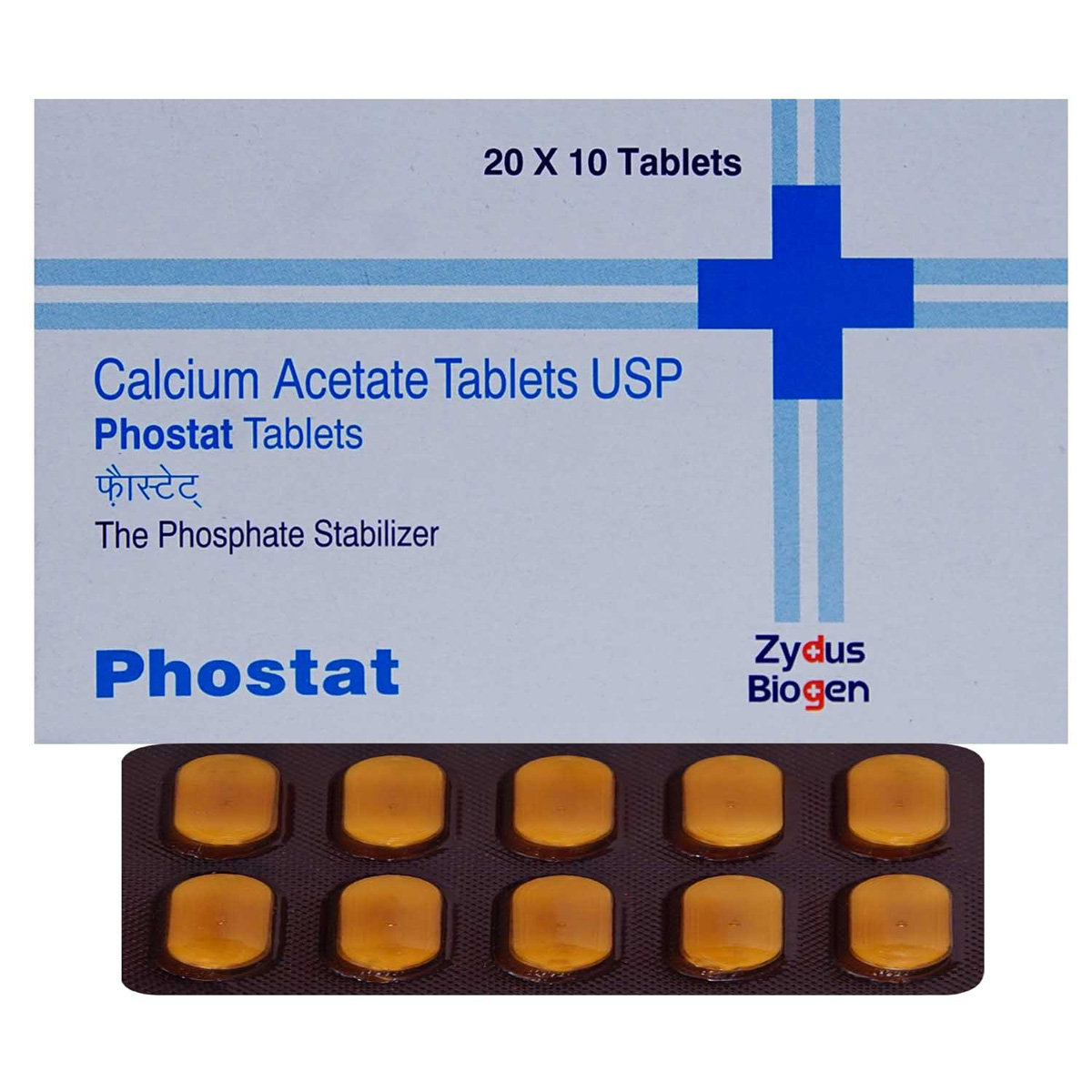
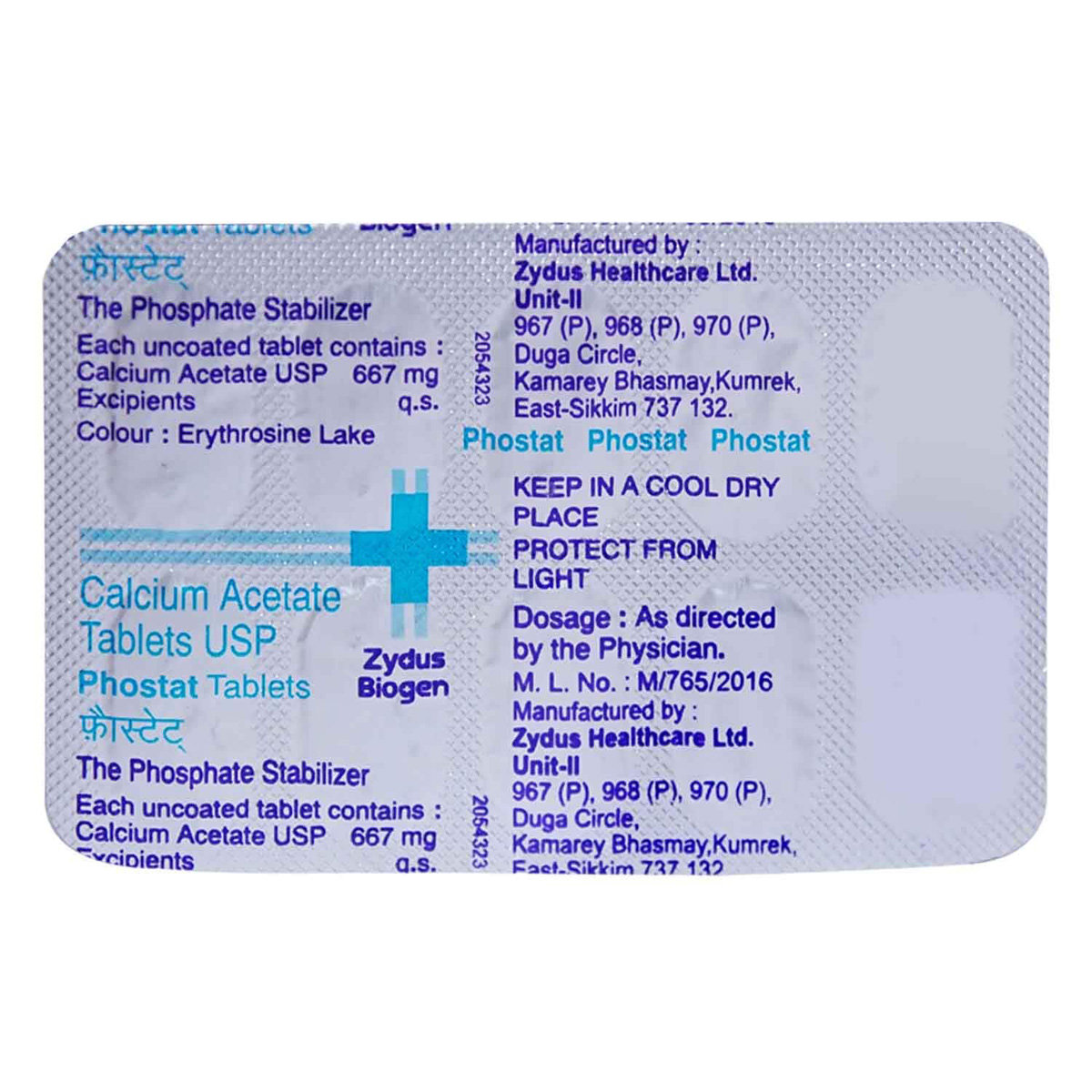
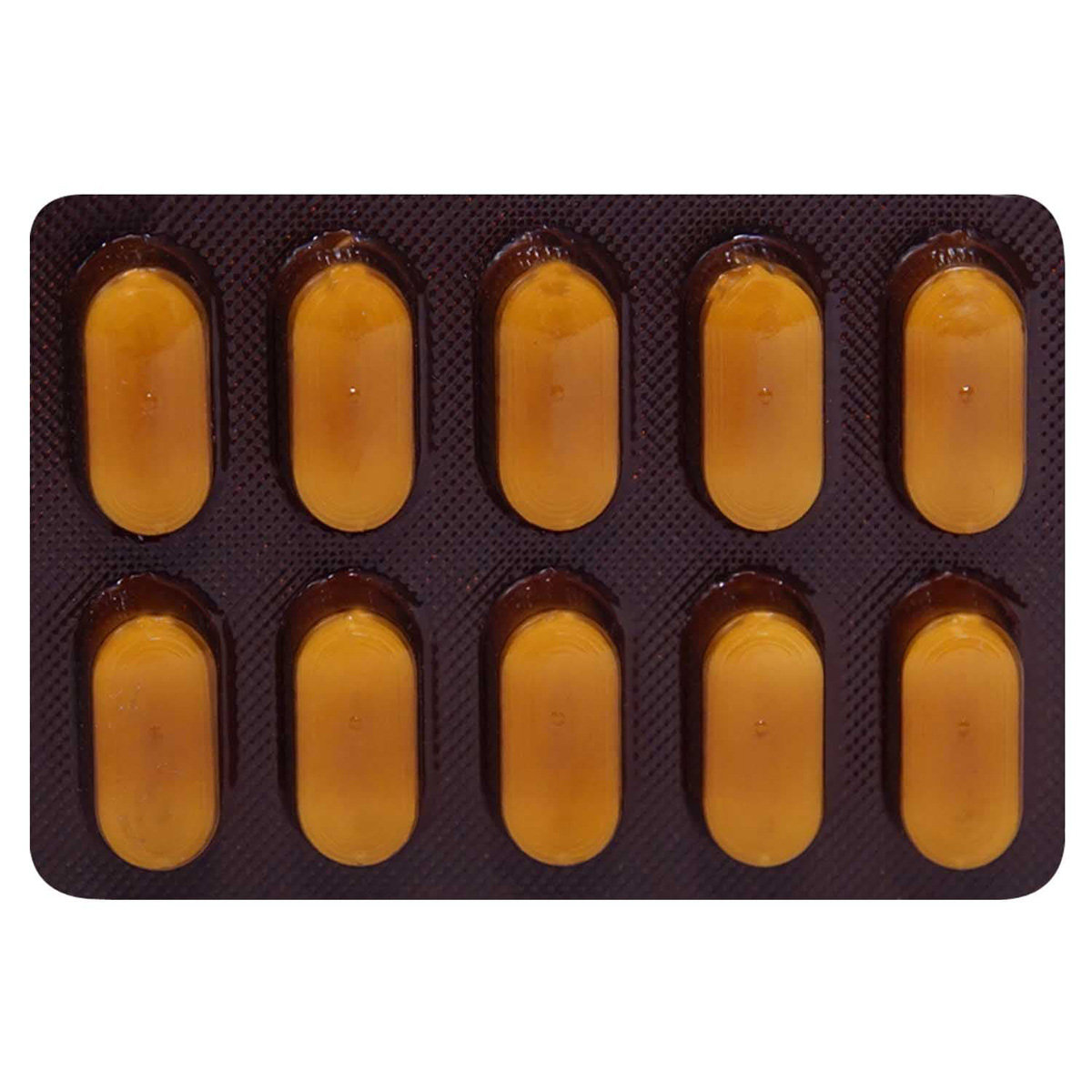
MRP ₹39.5
(Inclusive of all Taxes)
₹5.9 Cashback (15%)
Phostat Tablet is used to prevent high blood phosphate levels. It contains calcium acetate. It is commonly used to treat kidney failure in individuals undergoing regular haemodialysis or continuous ambulatory peritoneal dialysis (CAPD). In kidney failure, the phosphate levels in the blood can be high. Phostat Tablet controls the phosphate levels by removing phosphate from the food in your stomach before it enters the bloodstream. Thus, it helps to prevent the high phosphate levels in the stream.
Know Your Delivery Time
Provide Delivery Location

Secure Payment

India's Most Trusted Pharmacy

Genuine Products
Composition :
Manufacturer/Marketer :
Consume Type :
Return Policy :
Expires on or after :
About Phostat Tablet
Phostat Tablet belongs to the class of medicines known as phosphate binders. It is used to control high blood levels of phosphorus in people with kidney disease who are on dialysis (medical treatment to clean the blood when the kidneys are not working properly). High phosphorus, also called hyperphosphatemia, means you have extra phosphorus in your blood.
Phostat Tablet contains calcium acetate, which works by binding phosphorus that you get from foods in your diet and prevents it from being absorbed into your bloodstream.
Use Phostat Tablet as advised by your doctor. You may experience nausea (feeling sick) or vomiting (being sick), constipation and diarrhoea. Most of these side effects do not require medical attention and gradually resolve over time. However, if the side effects persist, contact your doctor.
Before taking Phostat Tablet , let your doctor know if you are allergic to any ingredient of it. Inform your doctor before taking Phostat Tablet if you are pregnant, planning to become pregnant, or breastfeeding if you have lactose intolerance, have high levels of calcium in your blood or urine, or have low levels of phosphate in your blood. It is recommended not to consume alcohol while on treatment with this medicine. Inform your doctor about your medical history and other medications you are currently taking to rule out any potential negative effects.
Description
Phostat tablets are used for managing hyperphosphatemia, a condition characterised by high levels of phosphate in the blood, especially in patients with chronic kidney disease.
This potent medication works by binding to phosphate in the digestive tract, thus preventing its absorption into the blood.
Phostat tablet effectively regulates your body's phosphate levels and helps maintain overall health with its active ingredient Calcium Acetate.
With its unique formulation and proven efficacy, this tablet ensures that your body receives the right balance of nutrients without compromising your health.
Please note that it is recommended to consult your doctor for specific usage and safety precautions necessary.
Features
- Contains the active ingredient Calcium Acetate
- Prevents phosphorus absorption from food in your diet into your bloodstream
- Typically taken with a meal or immediately after a meal
- Consumed orally with water
Uses of Phostat Tablet
Phostat Tablet is used to manage high phosphorus levels in people with kidney problems. The detailed uses of Phostat Tablet are as follows:
- Controls hyperphosphatemia: Phostat Tablet helps lower elevated blood phosphorus levels in patients with chronic kidney disease on dialysis.
- Acts as a phosphate binder: Phostat Tablet binds to dietary phosphorus in the gut, preventing its absorption into the bloodstream.
- Supports mineral balance: Phostat Tablet helps maintain healthier calcium and phosphorus levels to protect bones and blood vessels in kidney disease patients.

Have a query?
Directions for Use
- Phostat Tablet can be taken with meals to prevent stomach upset or as advised by your doctor.
- It is usually taken twice daily; however, follow your doctor’s advice regarding the dosage and duration.
- Swallow the medicine as a whole with a glass of water.
- Do not crush, chew or break it.
Medicinal Benefits
Phostat Tablet belongs to the class of medicines known as phosphate binders. It contains calcium acetate. It is commonly used to treat kidney failure in individuals undergoing regular haemodialysis or continuous ambulatory peritoneal dialysis (CAPD). In kidney failure, the phosphate levels in the blood can be high. Phostat Tablet controls the phosphate levels by removing phosphate from the food in your stomach before it enters the bloodstream. Thus, it helps to prevent the high phosphate levels in the stream.
How Phostat Tablet Works
Storage
- Stay hydrated by drinking plenty of water.
- Avoid dairy product such as cheese, milk, yogurt and ice cream.
- Maintain healthy weight and exercise daily.
- Following a low-calcium diet can help reduce hypercalcemia symptoms.
- Inform your doctor about the nausea and discuss possible alternatives to the medication or adjustments to the dosage.
- Divide your daily food intake into smaller, more frequent meals to reduce nausea.
- Opt for bland, easily digestible foods like crackers, toast, plain rice, bananas, and applesauce.
- Avoid certain foods that can trigger nausea, such as fatty, greasy, spicy, and smelly foods.
- Drink plenty of fluids, such as water, clear broth, or electrolyte-rich beverages like coconut water or sports drinks.
- Use ginger (tea, ale, or candies) to help relieve nausea.
- Get adequate rest and also avoid strenuous activities that can worsen nausea.
- Talk to your doctor about taking anti-nausea medication if your nausea is severe.
- Record when your nausea occurs, what triggers it, and what provides relief to help you identify patterns and manage your symptoms more effectively.
- Inform Your Doctor: Notify your doctor immediately about your diarrhoea symptoms. This allows them to adjust your medication or provide guidance on managing side effects.
- Stay Hydrated: Drink plenty of fluids to replace lost water and electrolytes. Choose water, clear broth, and electrolyte-rich drinks. Avoid carbonated or caffeinated beverages to effectively rehydrate your body.
- Follow a Bland Diet: Eat easy-to-digest foods to help firm up your stool and settle your stomach. Try incorporating bananas, rice, applesauce, toast, plain crackers, and boiled vegetables into your diet.
- Avoid Trigger Foods: Steer clear of foods that can worsen diarrhoea, such as spicy, fatty, or greasy foods, high-fibre foods, and dairy products (especially if you're lactose intolerant).
- Practice Good Hygiene: Maintain good hygiene to prevent the spread of infection. To stay healthy, wash your hands frequently, clean and disinfect surfaces regularly, and avoid exchanging personal belongings with others.
- Take Anti-Diarrheal Medications: If your doctor advises, anti-diarrheal medications such as loperamide might help manage diarrhoea symptoms. Always follow your doctor's directions.
- Keep track of your diarrhoea symptoms. If they don't get better or worse or are accompanied by severe stomach pain, blood, or dehydration signs (like extreme thirst or dark urine), seek medical help.
- Preventing Vomiting (Before it Happens)
- Take medication exactly as prescribed by your doctor. This can help minimize side effects, including vomiting.
- Having a small meal before taking your medication can help reduce nausea and vomiting.
- Talk to your doctor about taking anti-nausea medication along with your prescribed medication.
- Managing Vomiting (If it Happens)
- Try taking ginger in the form of tea, ale, or candy to help alleviate nausea and vomiting.
- What to Do if Vomiting Persists
- Consult your doctor if vomiting continues or worsens, consult the doctor for guidance on adjusting your medication or additional treatment.
- Report the itching to your doctor immediately; they may need to change your medication or dosage.
- Use a cool, damp cloth on the itchy area to help soothe and calm the skin, reducing itching and inflammation.
- Keep your skin hydrated and healthy with gentle, fragrance-free moisturizers.
- Try not to scratch, as this can worsen the itching and irritate your skin.
- If your doctor prescribes, you can take oral medications or apply topical creams or ointments to help relieve itching.
- Track your itching symptoms and follow your doctor's guidance to adjust your treatment plan if needed. If the itching persists, consult your doctor for further advice.
What if I have taken an overdose of Phostat Tablet
Drug Warnings
Before taking the Phostat Tablet , inform your doctor if you are allergic to any of its ingredients. If you are pregnant, planning to become pregnant, or breastfeeding, or if you have high levels of calcium in your blood or urine or low levels of phosphate in your blood. Long-term high calcium levels in your blood may lead to a build-up of calcium in your blood vessels or soft tissues. Your blood calcium levels will be checked on a regular basis by your doctor. If your levels are too high, your dose will be lowered, or your therapy will be stopped immediately. Other medications, especially antibiotics (such as norfloxacin, ciprofloxacin, or tetracyclines), diuretics (such as thiazides), and bisphosphonates (used to treat bone problems), should not be taken with Phostat Tablet unless prescribed by a doctor.
Drug-Drug Interactions
Drug-Drug Interactions
Login/Sign Up
Co-administration of Phostat Tablet may interfere with the absorption of Demeclocycline and reduce its effectiveness.
How to manage the interaction:
Taking Phostat Tablet may interfere with the absorption of Demeclocycline and reduce its effectiveness. Therefore, Phostat Tablet and demeclocycline should not be taken orally at the same time. Maintaining a gap of 2-4 hours between both medicines is advised. Do not discontinue the medication without consulting a doctor.
Co-administration of doxycycline with Phostat Tablet can reduce its effectiveness.
How to manage the interaction:
Although there is an interaction between Phostat Tablet and doxycycline, it can be taken together if prescribed by a doctor. It is adviced to take doxycycline 2 hrs before or 6 hours after taking Phostat Tablet. Do not stop using any medications without talking to a doctor.
Co-administration of Dolutegravir with Phostat Tablet can reduce the effectiveness of dolutegravir.
How to manage the interaction:
Taking Dolutegravir with Phostat Tablet together can possibly result in an interaction, they can be taken together if prescribed by your doctor. It is recommended to take dolutegravir at least two hours before or six hours after the Phostat Tablet dose. Do not discontinue any medications without consulting a doctor.
Co-administration of Oxytetracycline when taken along with Phostat Tablet lowers the levels of either medication. This interaction applies to the oral forms of both medications.
How to manage the interaction:
Although taking Oxytetracycline and Phostat Tablet together can result in an interaction, it can be taken if a doctor has prescribed it. Do not stop using any medications without talking to a doctor.
Phostat Tablet may interfere with the absorption of lymecycline and reduce its effectiveness.
How to manage the interaction:
Phostat Tablet may interfere with the absorption of lymecycline and reduce its effectiveness. Although there is an interaction, Phostat Tablet can be taken with lymecycline if prescribed by the doctor.
Drug-Food Interactions
Drug-Food Interactions
Login/Sign Up
Diet & Lifestyle Advise
- Maintain a well-balanced and healthy diet.
- Keep your weight under control with a BMI of 19.5-24.9
- Eat low-phosphorus foods such as sourdough bread, corn or rice cereals, cream of wheat, unsalted popcorn and some light-coloured sodas & lemonade.
- Avoid high-phosphorus foods, including bran cereals, oatmeal, nuts, sunflower seeds, whole-grain bread and dark-coloured colas.
- Limit or avoid alcohol consumption.
- Quitting smoking is the best strategy to lower the risk of illness.
Habit Forming
Therapeutic Class
RX
Hypophos 677 mg Tablet 10's
Samarth Life Sciences Pvt Ltd
₹18
(₹1.62 per unit)
54% CHEAPERRX
Low Phos 667 mg Tablet 50's
Atlantic Pharmaceuticals Inc
₹117
(₹2.11 per unit)
40% CHEAPERRX
Phocel Tablet 10's
Celera Healthcare Pvt Ltd
₹36.5
(₹3.29 per unit)
7% CHEAPER
Alcohol
Caution
Avoid the consumption of alcohol as it may cause some side effects and make Phostat Tablet less effective.
Pregnancy
Caution
Phostat Tablet should not be used in pregnancy unless clearly necessary. So, inform your doctor if you are pregnant or suspect pregnancy. Your doctor will weigh the benefits and potential risks before prescribing Phostat Tablet .
Breast Feeding
Caution
Phostat Tablet should not be used in nursing mothers unless clearly necessary. Inform your doctor if you are breastfeeding. Your doctor will weigh the benefits and potential risks before prescribing Phostat Tablet .
Driving
Safe
Phostat Tablet does not affect your ability to drive or operate machinery.
Liver
Caution
If you have liver problems, inform your doctor before taking Phostat Tablet . Your doctor may adjust the dose of this medicine based on your condition.
Kidney
Caution
If you have a pre-existing or a history of kidney condition, inform your doctor before taking Phostat Tablet . Your doctor may adjust the dose of this medicine based on your condition.
Children
Consult your doctor
Safety and effectiveness in pediatric patients have not been established. Please consult your doctor.
Heart
Phostat Tablet can be taken by individuals with heart problems, but only under medical supervision. Excess calcium may worsen conditions like arterial calcification or interact with heart medications, so dosage and timing must be carefully managed.
Geriatrics
Caution
Geriatric patients can take Phostat Tablet , but it may be more sensitive to its effects. Careful dosing and regular monitoring of calcium levels are important to avoid complications like hypercalcemia.
FAQs
Phostat Tablet is used to manage high levels of phosphate in the blood of people with chronic kidney-related concerns. It helps manage high levels of phosphate in the blood and reduces the risk of complications associated with high phosphate levels.
Phostat Tablet controls the phosphate levels by removing phosphate from the food in your stomach before it gets into the bloodstream. Thus, it helps to prevent the high levels of phosphate in the bloodstream.
High phosphorus often does not cause symptoms itself. However, excess phosphorus in your blood can remove calcium from your bones and other body parts, resulting in low calcium (hypocalcemia). Low calcium causes symptoms such as muscle cramps, bone and joint discomfort, weak bones, and itchy skin or rash.
It is not recommended for use if you are allergic to any components present in Phostat Tablet , if you have high levels of calcium in your blood or urine, or if you have low levels of phosphate in your blood.
Doctors will test your blood phosphate level to see if you have excess phosphorus. If your phosphate level is higher than 4.5 mg/dL, your doctor may order additional tests to rule out kidney disease.
Phostat Tablet may cause side effects such as nausea, vomiting, diarrhoea and constipation. If these side effects persist or worsen, please consult your doctor.
Milk, paneer, cheese, curd and other dairy products, chinese cabbage, broccoli and kale are good sources of calcium.
If you have kidney problem or kidney stone, tissue calcification (deposit of calcium in body tissues) and if you are taking water pills, medicine for heart failure or any other calcium containing medicines or supplements, inform your doctor.
Yes, Phostat Tablet is a health supplement and taking too much of it can be harmful. An overdose can cause stomach discomfort. If you think you have taken too much of Phostat Tablet , seek medical help immediately.
A: Taking the Phostat tablet with meals or immediately after a meal is recommended to enhance its effectiveness.
The onset of action varies from person to person. Following your doctor's instructions and monitoring your phosphate levels regularly as per directions for the best result.
It is essential to consult your doctor before stopping any medication. They will determine the duration of treatment based on your specific condition.
Phostat tablet is primarily used for managing hyperphosphatemia in patients with chronic kidney disease. If you have kidney stones, consult your doctor for appropriate treatment options.
Country of origin
Manufacturer/Marketer address
In the Spotlight
Customers Also Bought
Disclaimer
Author Details
We provide you with authentic, trustworthy and relevant information
Reference
- https://www.kidneyfund.org/living-kidney-disease/health-problems-caused-kidney-disease/high-phosphorus-hyperphosphatemia#:~:text=High%20phosphorus%2C%20also%20called%20hyperphosphatemia,2.5%20to%204.5%20mg%2FdL.
- https://www.drugs.com/drug-interactions/calcium-acetate.html
- https://medlineplus.gov/druginfo/meds/a620017.html
- https://www.accessdata.fda.gov/drugsatfda_docs/label/2011/021160s015lbl.pdf
- https://www.hpra.ie/img/uploaded/swedocuments/f1814b11-8a2c-41e0-95a1-7de958a5d7f4.pdf
Buy best Health & Nutrition products by
SPECIALITY SUPPLEMENTS
Minerals
VITAMINS AND MINERALS
VITAMINS
OTHER SUPPLEMENTS
ADULT NUTRITION
Protein Supplements
OMEGA & FISH OIL
SINGLE VITAMIN
WEIGHT LOSS
KIDS NUTRITION
SEXUAL HEALTH SUPPLEMENTS
BONE & JOINT SUPPLEMENTS
AMINO ACIDS
WELLNESS DRINKS
WOMEN HEALTH SUPPLEMENTS
WEIGHT GAIN
AMINO ACID SUPPLEMENTS
IMMUNE HEALTH SUPPLEMENTS
HEALTH FOODS
MULTIVITAMINS
CARDIAC SUPPLEMENTS
GASTRIC DISORDERS SUPPLEMENTS
HEMATINICS
WEIGHT LOSS AND WEIGHT GAIN
DIABETICS SUPPLEMENTS
Others
AYUR
HIMALAYAN ORGANICS
WELLBEING NUTRITION
HEALTHVIT
HORLICKS
GNC
PURE NUTRITION
MUSCLEBLAZE
FAST&UP
ENSURE
PATANJALI
PROTINEX
SHELCAL
Optimum Nutrition
SUGAR FREE
Pediasure
CENTRUM
PROHANCE
SWISSE
APOLLO PHARMACY
PENTASURE
Himalaya
RITEBITE
GROVIVA
Muscletech
OZIVA
QNT
APOLLO LIFE
COMPLAN
THE VITAMIN COMPANY
VOGUE WELLNESS
BEAUTYWISE
NEAT
BODYWELL
CUREVEDA
REVITAL
CELEVIDA
ORIGIN
RASAYANAM
THE GOOD BUG
HEALTHKART
CALCIMAX
BOURNVITA
EQUAL
HEALTH OK
B-PROTIN
ESSENTIAL
ISOPURE
ULTRA
WEST COAST
MAXVIDA
GALACT
HEALTHYR-U
NESTLE RESOURCE
NEUHERBS
PRESURE
SUPRADYN
THE WHOLE TRUTH
A TO Z
ARTH
Diataal
INJA
MAXIRICH
NUTRASWISS
Power Gummies
VIVAMOM
ZINCOVIT
BAIDYANATH
Cipcal
ESPERER
ORGANIC INDIA
PROTOTAL
TORGEM
ULTRA D3
ZANDU
ZEST
BOOST
CALIBAR
D-PROTIN
ECOPROT
FITSPIRE
IN YOU
Livogen
MY FITNESS
OSTOCALCIUM
PRO-PL
Performance Inspired
THREPTIN
BIOVIT
CHARAK
ENERZAL
Evion
FRESUBIN
LACTARE
LAMINO
MACPROT
MANNA
NURTURE
VIDAVANCE
Vlado Sky Enterprise Pvt Ltd
Sun Pharmaceutical Industries Ltd
Intas Pharmaceuticals Ltd
Abbott India Ltd
Macleods Pharmaceuticals Ltd
Mankind Pharma Pvt Ltd
Alkem Laboratories Ltd
West Coast Pharmaceuticals Pvt Ltd
Lupin Ltd
Emcure Pharmaceuticals Ltd
Meyer Organics Pvt Ltd
Eris Life Sciences Ltd
Nutritionalab Pvt Ltd
Akumentis Healthcare Ltd
Cipla Ltd
Torrent Pharmaceuticals Ltd
Alniche Life Sciences Pvt Ltd
British Biologicals
La Renon Healthcare Pvt Ltd
Micro Labs Ltd
Leeford Healthcare Ltd
Zuventus Healthcare Ltd
Pharmed Ltd
Corona Remedies Pvt Ltd
Dr Reddy's Laboratories Ltd
East West Pharma India Pvt Ltd
Modi Mundipharma Pvt Ltd
Bright Lifecare Pvt Ltd
ABBOTT HEALTHCARE PVT LTD
Indchemie Health Specialities Pvt Ltd
Koye Pharmaceuticals Pvt Ltd
Apex Laboratories Pvt Ltd
Aristo Pharmaceuticals Pvt Ltd
Zydus Healthcare Ltd
DR Johns Lab Pharma Pvt Ltd
Bioceutics Inc
Hindustan Unilever Ltd
Vasu Organics Pvt Ltd
Fourrts India Laboratories Pvt Ltd
Zydus Cadila
Alembic Pharmaceuticals Ltd
USV Pvt Ltd
Elder Pharmaceuticals Ltd
Indoco Remedies Ltd
ZYDUS WELLNESS LIMITED
FDC Ltd
Herbs Nutriproducts Pvt Ltd
Morepen Laboratories Ltd
Guardian Healthcare Services Pvt Ltd
Zee Laboratories Ltd
TTK Healthcare Ltd
Troikaa Pharmaceuticals Ltd
Pulse Pharmaceuticals
Raptakos Brett & Co Ltd
Innovcare Life Sciences Pvt Ltd
Levin Life Sciences Pvt Ltd
Cadila Pharmaceuticals Ltd
Glanbia Performance Nutrition India Pvt Ltd
Linux Laboratories Pvt Ltd
Wockhardt Ltd
Ajanta Pharma Ltd
Medley Pharmaceuticals Ltd
Primus Remedies Pvt Ltd
Sanofi India Ltd
Wanbury Ltd
Adonis Laboratories Pvt Ltd
Hexagon Nutrition Pvt Ltd
Aareen Healthcare Pvt Ltd
Kepler Healthcare Pvt Ltd
Sanatra Healthcare Ltd
Tablets India Ltd
Tas Med India Pvt Ltd
Cadila Healthcare Ltd
Medishri Healthcare Pvt Ltd
Overseas Health Care Pvt Ltd
Radicool Pharmaceuticals Pvt Ltd
Anglo French Drugs & Industries Ltd
Daris Biocare
Elbrit Life Sciences Pvt Ltd
Maxamus Pharma Pvt Ltd
Ordain Health Care Global Pvt Ltd
Panacea Biotec Ltd
Procter & Gamble Health Ltd
Icarus Health Care Pvt Ltd
Klm Laboratories Pvt Ltd
Nutricia International Pvt Ltd
Patanjali Ayurved Limited
Winmark Healthcare Pvt Ltd
Biovitamins Pvt Ltd
Mova Pharmaceutical Pvt Ltd
Ozone Pharmaceuticals Ltd
Signova Pharma
Cachet Pharmaceuticals Pvt Ltd
Femura Pharmaceuticals Pvt Ltd
Lloyd Healthcare Pvt Ltd
Med Manor Organics Pvt Ltd
Aeronutrix Sports Products Pvt Ltd
Akesiss Pharma Pvt Ltd
Delcure Life Sciences Ltd
Hs Aldem Healthcare
SPECIALITY SUPPLEMENT
CALCIUM
Specialty Supplements
VITAMIN D
IRON
VITAMIN B12
VITAMIN B
VITAMIN C
COLLAGEN
FISH OIL OMEGA
Adult Nutrition Drink
MULTIVITAMIN
ZINC
VITAMIN B9
VITAMIN E
WHEY PROTEIN
Kids Nutrition Drink
SEXUAL HEALTH SUPPLEMENT
MAGNESIUM
SPECIALITY NUTRITION DRINK
Protein Powder
VITAMIN B1
SUGAR SUBSTITUTE
Prebiotic & Probiotic
DIABETIC NUTRITION DRINK
Protein Bar
BIOTIN
WEIGHT LOSS
ENERGY DRINK
Fat Burner
PLANT PROTEIN POWDER
WOMEN & MOTHER NUTRITION DRINK
Apple Cider Vinegar
MELATONIN
Lactation Supplements
APPETITE STIMULANT
Flax seed Oil
VITAMIN A
ORS
AMINO ACID
Pregnancy Supplements
Ashwagandha
Meal Replacement
POTASSIUM
Pre Workout
Shilajit
VITAMIN B6
L-Carnitine
VITAMIN K
CURCUMIN
Mass Gainer
CREATINE
Cod Liver Oil
Ayurvedic Capsules
VITAMIN B5
ARGININE
Glutathione
VITAMIN B2
COENZYME Q10
Chromium
Women Nutrition
MILK THISTLE
VITAMIN B3
Appetite Suppressant
Ayurvedic Tablets
Chyawanprash
Kids Gummies
MORINGA
L-Glutamine
SPIRULINA
GARCINIA CAMBOGIA
HERBAL JUICE
Instant Food
WEIGHT GAINER
ALPHA-LIPOIC ACID
DISKETTE
GLUCOSAMINE
GOKSHURA
Tulsi
ANTACID
BCAA Protein Powder
Brahmi
Chocolate
GILOY
NEEM
NUTRITION DRINK
SELENIUM
TRIPHALA
Amla
BREAKFAST CEREAL
GREEN TEA
Honey
IMF STAGE-2
MILKSHAKE
PAIN RELIEF TABLET
Recommended for a 30-day course: 3 Strips


